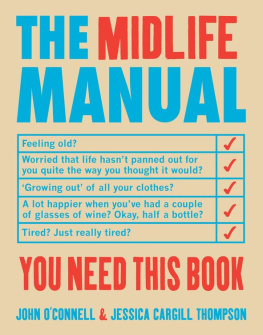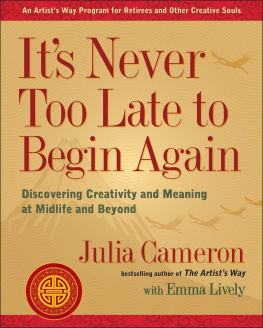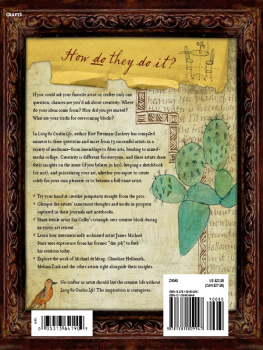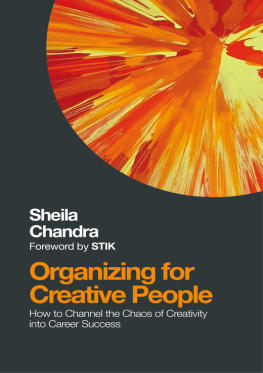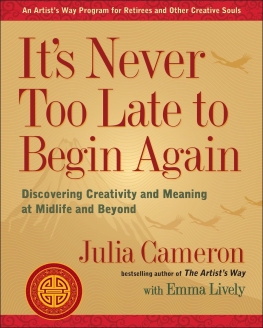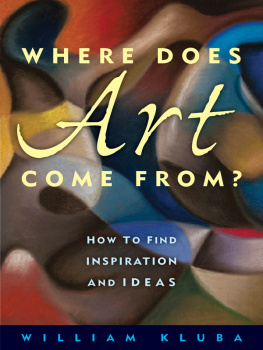MIDLIFE CREATIVITY AND IDENTITY
MIDLIFE CREATIVITY AND
IDENTITY: LIFE INTO ART
BY
PHILIP MILES
University of Bedfordshire, UK
Emerald Publishing Limited
Howard House, Wagon Lane, Bingley BD16 1WA, UK
First edition 2019
Copyright 2019 Philip Miles. Published under exclusive licence by Emerald Publishing Limited.
Reprints and permissions service
Contact:
No part of this book may be reproduced, stored in a retrieval system, transmitted in any form or by any means electronic, mechanical, photocopying, recording or otherwise without either the prior written permission of the publisher or a licence permitting restricted copying issued in the UK by The Copyright Licensing Agency and in the USA by The Copyright Clearance Center. Any opinions expressed in the chapters are those of the authors. Whilst Emerald makes every effort to ensure the quality and accuracy of its content, Emerald makes no representation implied or otherwise, as to the chapters suitability and application and disclaims any warranties, express or implied, to their use.
British Library Cataloguing in Publication Data
A catalogue record for this book is available from the British Library
ISBN: 978-1-78754-334-8 (Print)
ISBN: 978-1-78754-333-1 (Online)
ISBN: 978-1-78754-335-5 (Epub)
In memory of Claire Rosalind Miles 19742015
Contents
Acknowledgements
It is right and proper to begin acknowledgements with a shout out to those who took part in the research by giving me their time, energies and thoughts about the creative process. Therefore, big appreciation goes to Johnny Vincent, Duncan McIntyre, Ian Burton, CJ Bailey and Miles Simpkins of The Ruins and to Ians wife, Sharon, for hosting us for group interviews and the weekly jam, rehearsals and recording sessions. It was a joy to be there. Thanks also to Peter Driver and Robin Wilson for their invites to join them at their studios in Reading and Oxford and for their detailed, fabulous thoughts on inspiration, action and value. They were awe-inspiring meetings where I learned so much about the artistic muse and the strength of the individual will to make things happen. Thanks also go to Katherine Webb for her insight on writing and authorial routines and for the most excellent cake and tea during numerous visits to her home. Appreciation is also due to those who have taken part in the research process but have chosen to remain anonymous for various reasons; it goes without saying that I respect and understand your ideas, thoughts and motives equally and would like to thank you for your time and hospitality.
Appreciation also goes to a variety of people who have assisted and encouraged me at various stages along the way, all equally inspiring: Graham Falgate; Chris Cheetham and Doris Crick; Nick Ellison, Steve Fuller and Chris Llewellyn; Ray Jobling, Rob Moore and Madeleine Arnot; Paul Willis and Phillip Brown; and to my Editor at Emerald, Philippa Grand, who gave this book a chance to exist, and to her colleagues Rachel Ward and Charlotte McSharry. Many thanks to my academic colleagues Andy Bennett (Griffith University) and Gary Manders (University of Bedfordshire) for their comments on earlier drafts of this book and for the encouraging early feedback of the anonymous referees. Respect and appreciation is also due to Paul Innes and John Hughes (University of Gloucestershire) and Rebecca Beasley (University of Oxford) for positively instilling the incentive to combine sociology with literary studies and to embrace the art of the possible. It is a work in progress, but the destination is now clear. A special mention is also due to Steve Hardy (scriptwriter, journalist, musician, raconteur) who has provided creative inspiration and the most exceptional friendship throughout my adult life while himself being a most dedicated contributor to, and supporter of, the creative arts in many forms.
Finally, the process of writing this book has been, in time-honoured fashion, suitably riddled with the most invigorating of stress, but to those who have experienced me daily as this oscillating level of anxiety has fired the process Maria, Sebastian and Huw the greatest debt to you must be acknowledged. I love you all. Indebtedness must also go to my wonderful parents, Ron and Yvonne Miles, who have given me the love and unconditional support to help me achieve goals in life. Finally, this book is dedicated to the memory of my sister, Claire Rosalind Miles, whose presence among us I miss every day.
Introduction: Life into Art
Where does art come from? What are the routines and inspirations that bring works of art into being and where are these actions and inspirations acted out, made sense of and exploited? In the coming study, it is my intention to introduce, investigate and explain creative processes via the lives, work and subjectivities of 10 people engaged in the generation of musical, artistic and literary texts for public consumption, all entering or experiencing middle-age (or midlife as it shall be referred to throughout) and living in England. These people are both distinctive and alike in many ways; they are male and female, working class and middle class, educated in different sectors and to differing levels and working in different ways, but they are also all engaged in what I call an authorial routine based on transforming ideas into art forms via sound, visuals and the written word. The participants in this study are approaching their work in a variety of formats by utilising an assortment of skills to achieve tangible outcomes but are aiming, ostensibly, for the same conclusions both in terms of a sense of contribution and completion as well as obtaining a bolstered self-efficacy and satiation of artistic energies. Therefore, whether differentiated by gender, class or skill set, the participants are dedicated to the articulation of imagination and the realisation of novelty.
The narrative at the heart of this volume will involve a subtle mixture of foci that encompasses the dynamics of midlife, identity and creativity running throughout the text, never isolated entirely from one another but perceived as distinctive at times, prominent and energetic in their functions. It is the intention that the reader can consider the dynamics as interlinked and supra-determinant in the lives of the participants featured here and further within the analysis of their arts, routines and inspirations. While contemplating the format of presenting the research, I decided that I would offer an introductory chapter that set out the context, form and theoretical influences of the process before introducing the data via the themes of music, art and literature, organised into corresponding thematic sections. These subdivisions will be expansive, handing over the focus of the narrative to the people who made the research come to life namely those musicians, artists and writers whose daily core activity is to consider and create and make new and exciting things. These things are works of art that incorporate a process, or routine, that enables the inventive individual (or group) to step away from the humdrum of the everyday and into a zone where the anxieties of what I shall refer to as late modernity are quelled in a space of innovative zeal. The ethnography driven by observation and interviews and the explanations proffered on meaning of art and craft was designed only to seek and understand the culture of creativity that exists in some middle-aged people, the incentives to create, the sense of worth that emerges from the process and the comparator of midlife routine in the real world. What emerged was a series of fascinating portraits of artists as middle-aged men and women and some secrets about where it was that they went to when they sought to summon the inventive muse. This was not a project that sought to prove or disprove a pre-existing idea or theory within the broader cultural study of creativity. Instead, I let the artists do the talking first, guided only by questions that I wished to ask on


